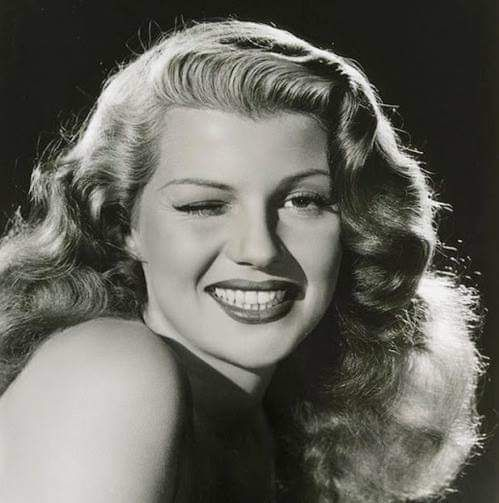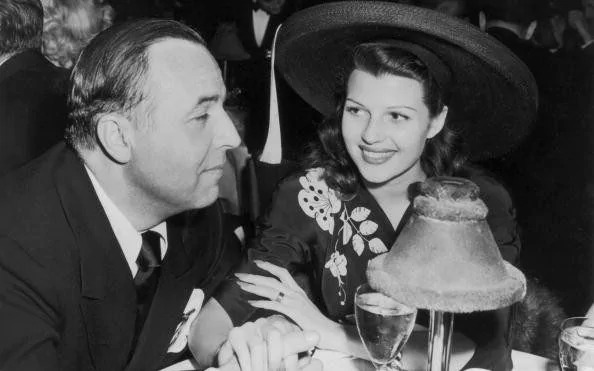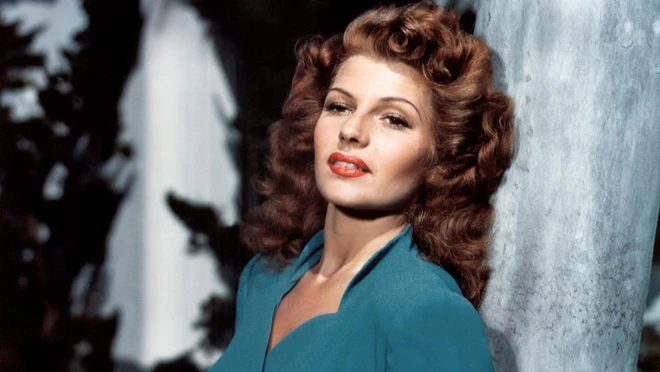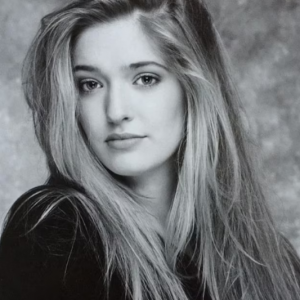The timeless beauty and immense talent of Rita Hayworth secured her place as one of Hollywood’s most captivating stars. Known as the “Goddess of Love,” Hayworth was the very definition of glamour and allure on the silver screen during the 1940s. Yet, beneath the shine of fame, her life was riddled with hardship, personal trauma, and sorrow. From her troubled early years to multiple turbulent marriages and a painful descent into illness, Hayworth’s story is one of resilience overshadowed by a life filled with challenge.
A Star Born into Darkness: Early Life and Childhood Trauma

Born Margarita Carmen Cansino on October 17, 1918, in Brooklyn, New York, Rita Hayworth’s early years were anything but ideal. Her father, Eduardo Cansino, a Spanish flamenco dancer, harbored big dreams for his daughter. At just 12, she was pulled out of school to perform as his dance partner in their act, The Dancing Cansinos. Under bright stage lights and heavy makeup, Hayworth was thrust into an adult world she was far too young for. To sidestep U.S. child labor laws, Eduardo moved their performances to nightclubs and gambling boats, even passing her off as his “wife” to gain access to venues. These early experiences would scar Hayworth emotionally for years to come.
The trauma she endured wasn’t limited to the stage. Barbara Leaming’s biography on Hayworth reveals disturbing details, including allegations of abuse by her father. These early years of control and exploitation left lasting impacts on her sense of self-worth and would later shape her relationships and career in unforeseen ways.
Hollywood Transformation: From Margarita Cansino to Rita Hayworth
In 1935, when Hayworth was only 16, a Fox studio producer discovered her while she was performing in Agua Caliente, Mexico. This chance encounter marked the beginning of her Hollywood journey, though it came at a high personal cost. The studio quickly set out to transform her, encouraging her to shed her Spanish roots to fit the “all-American” beauty ideal. She dyed her naturally black hair to a rich auburn, underwent electrolysis to raise her hairline, and changed her name to the now-iconic “Rita Hayworth.”
Her first husband, Edward Charles Judson, played a significant role in molding her new persona. Judson, a 41-year-old salesman, became her manager and saw her as an “investment” rather than a person. He used manipulative tactics to advance her career, reportedly even offering her to influential studio executives to secure roles. Judson’s treatment was emotionally abusive and financially exploitative, with him taking a large cut of her earnings. It wasn’t until 1942 that Hayworth found the courage to divorce him, though the psychological damage lingered, leaving her wary and vulnerable.
Rise to Stardom and the Role of Gilda

By the early 1940s, Hayworth’s career began to flourish, especially after signing with Columbia Pictures. Studio head Harry Cohn recognized her star potential, casting her in roles that emphasized her beauty and allure. Her performance in Only Angels Have Wings (1939) alongside Cary Grant put her on the map, and roles opposite Fred Astaire in You’ll Never Get Rich and Tyrone Power in Blood and Sand followed, cementing her status as a rising star.
However, it was her role as Gilda in the 1946 film Gilda that immortalized her. Her sultry portrayal of Gilda Mundson Farrell captured audiences, making her an enduring symbol of Hollywood sensuality. Yet, while the character of Gilda was a confident seductress, Hayworth herself was plagued by self-doubt and discomfort with her public image. The role became both a blessing and a curse, with Hayworth later admitting, “The men I know are all crazy about Gilda, but I’m just Rita.” She felt trapped by Hollywood’s expectations, a shadow cast by her own on-screen persona.
A Series of Tumultuous Marriages and Heartbreak

While Hayworth’s film career soared, her personal life remained fraught with challenges, particularly in her relationships. Each marriage added another layer to her tragedy, leaving her more disillusioned.
- Edward Charles Judson: Hayworth’s first husband, Judson, manipulated and exploited her for his own gain. This marriage ended when she finally took the brave step of divorcing him, though not without emotional scars.
- Orson Welles: After her divorce, Hayworth married director and actor Orson Welles, with whom she shared a daughter, Rebecca. Though the relationship started with excitement, it was soon plagued by Welles’ controlling behavior and infidelity. Despite a final attempt to mend their bond by co-starring in The Lady from Shanghai (1947), they divorced in 1947. Welles later reflected that Hayworth was one of the kindest women he’d known, though they couldn’t find lasting happiness.
- Prince Aly Khan: Hayworth’s third marriage was to Prince Aly Khan, a wealthy playboy with whom she had her second daughter, Princess Yasmin. While the union had the glamour of royalty, it ended in disappointment, with Khan’s infidelities leaving Hayworth feeling abandoned and alone. Their divorce was finalized in 1953.
- Dick Haymes: Her fourth husband, singer Dick Haymes, was perhaps her most turbulent partner. Known for his volatile behavior and struggles with alcohol, Haymes subjected Hayworth to both emotional and physical abuse, even leaving her financially drained. After one particularly violent public altercation, she filed for divorce.
- James Hill: Her final marriage was to director James Hill, and though it started with promise, it ended in constant arguments and frustration. They divorced in 1961, marking the end of her hopes for a stable relationship.
Each of these marriages left Hayworth more wounded and weary, yet she persisted, continuing to work and provide for her children despite the heavy personal toll.
A Slow Decline: Health Struggles and Final Years

By the late 1950s, Hayworth’s health began to deteriorate, affecting her ability to work. Despite attempts to revive her career, signs of alcoholism and early Alzheimer’s disease—though undiagnosed at the time—began to emerge. Her declining memory and frequent mood swings were attributed to alcohol abuse, though it was her illness that was truly to blame.
In 1980, she was finally diagnosed with Alzheimer’s, becoming one of the first public figures to bring awareness to the disease. Her daughter Yasmin took on the role of primary caregiver, supporting Hayworth through her final, difficult years. Hayworth spent her last days in a quiet New York apartment, far from the Hollywood spotlight.
Legacy of a Hollywood Icon: Remembering Rita Hayworth
Rita Hayworth’s life was one of extraordinary beauty and talent, yet it was shadowed by hardship and sorrow. She achieved legendary status, yet behind the scenes, she endured personal struggles that few knew about. Exploited in her youth, betrayed by the men she loved, and forced to conform to an industry’s narrow standards, Hayworth’s story is a testament to the human cost of fame.
In 1987, Hayworth passed away, leaving a legacy marked by unforgettable performances and undeniable resilience. Her name remains synonymous with Hollywood glamour, yet her life story reveals the complex reality behind her image. Rita Hayworth will always be remembered as a screen legend, but her life reminds us of the challenges women faced in Hollywood’s Golden Age—challenges that many continue to face today.
Though she became Hollywood’s “Goddess of Love,” Hayworth’s life was no fairy tale. Her iconic image may endure, but it’s the strength and spirit of Margarita Carmen Cansino that resonates, reminding us of her journey through a life that was far more than what appeared on screen.


